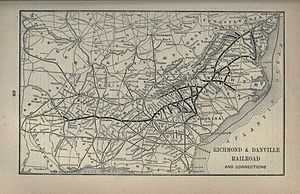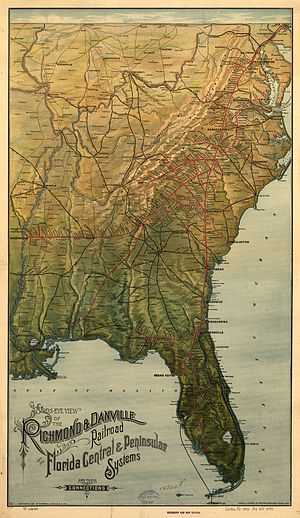Richmond and Danville Railroad
| Richmond and Danville Railroad | |
|---|---|
 1882 map of the Richmond and Danville Railroad and connections | |
| Locale |
Virginia Leased lines in North Carolina, South Carolina, Georgia |
| Dates of operation | 1847–1894 |
| Successor | Southern Railway |
| Track gauge | 4 ft 8 1⁄2 in (1,435 mm) |
| Previous gauge |
5 ft (1,524 mm) American Civil War era |
| Headquarters | Richmond, Virginia |
The Richmond and Danville Railroad (R&D) Company was a railroad that operated independently from 1847 until 1894, first in the U.S. state of Virginia and later on 3,300 miles (5,300 km) of track in nine states.
Chartered on March 9, 1847, the railroad completed its 140-mile (230 km) line between Richmond and Danville in 1856.[1] During the American Civil War, the railroad was a vital link between Richmond, the Confederate capital, and the rest of the Confederacy.[2]After the Civil War, the railroad grew to become the 3,300-mile Richmond and Danville Railroad Company System.
Placed in receivership in 1892, the Richmond and Danville Railroad Company was sold in 1894 and conveyed into the new Southern Railway Company in 1896 and 1897.
History
Beginnings (1847-61)
The new Richmond and Danville Railroad was championed by Whitmell P. Tunstall, a lawyer in Chatham, Virginia who was also a member of the Virginia General Assembly. In 1847, the state of Virginia took a 60% interest in the capital stock of the company, which it would hold until 1871.[3]
Construction on the 144.7 miles (232.9 km) line began in 1849 under the supervision of Col. Andrew Talcott, who was later to become the Richmond and Danville's general manager. By 1850, the new railroad had reached Coalfield Station, near the coal mines in an area known today as Midlothian in western Chesterfield County. There, it competed with the mule-powered Chesterfield Railroad. Lawsuits followed, but the older railroad, the first in Virginia, was quickly supplanted by the competition.
By the end of 1851, the new line had reached Jetersville in Amelia County. Two years later, it was completed to a point near Drakes Branch, and had been graded to South Boston in Halifax County.
US Civil War (1861–1865)
Known as the "first railroad war," the American Civil War left the South's railroads and economy devastated. In 1862, the Richmond and York River Railroad played a crucial role in George McClellan's Peninsula Campaign. After the war, it was to be acquired by the Richmond and Danville (R&D) Railroad.
The Richmond and Danville Railroad was an essential transportation link for the Confederacy throughout the war. It provided the production of south-central Virginia to Richmond. When the Richmond and Petersburg Railroad was cut in 1864, the R&D's connection with the Piedmont Railroad was the only remaining connection from Richmond to the rest of the South.
During the Civil War, the Confederate Army was handicapped by a lack of supplies when there often were plenty of supplies in the depots, but the quartermaster corps of the southern army was unable to deliver the goods efficiently. In one case, however, the war finally forced the Confederate government to over-rule objections by North Carolina. That state had blocked construction of a rail connection from Greensboro to Danville, fearing that after the war trade from North Carolina's Piedmont would continue to flow to Richmond via the R&D.
Following successful Union attacks on April 1, 1865, Confederate Gen. Robert E. Lee decided to abandon Petersburg and head west and south in an attempt to join Gen. Joseph Johnston's army in North Carolina.
After evacuating Richmond the next day, on April 2, 1865, Confederate President Jefferson Davis and his cabinet left Richmond on the R&D. The departing Confederates set fire to the bridge across the James River between Richmond and Manchester. They traveled to Danville, where they attempted to set up a temporary government.
On reaching Amelia Courthouse during the morning of April 4, 1865, Lee's first thought was for the commissary stores. He found ordnance supplies in abundance, but no food. Lee waited 24 hours in vain there for R&D trains to arrive with badly needed supplies. Union cavalry, meanwhile, sped forward and cut the Richmond & Danville at Jetersville. Lee had to abandon the railroad, and his army stumbled across rolling country towards Lynchburg. On the morning of April 9, 1865, "Palm Sunday", Lee met Grant in the front parlor of Wilmer McLean's home near Appomattox Court House to surrender.
Reconstruction (1865–94)



With the support of Virginia Governor Francis H. Pierpont, on September 13, 1865, Algernon S. Buford became president of the 140-mile (230 km) Richmond and Danville Railroad. Damage from the war, including the bridge across the James River between Manchester and Richmond was repaired.
Over the next 20 years, as R&D President, Buford and leaders including Richmonder James H. Dooley extended the trackage to three thousand miles.[4] The R&D's early acquisitions included the Piedmont Railroad in 1866, and a 25-year lease of the North Carolina Railroad in 1871.
In 1871, the Southern Railway Security Company acquired the state of Virginia's 60% stake in the railroad, and along with the Pennsylvania Railroad Company, controlled the Richmond and Danville Railroad until 1880.[5] In 1880, the Clyde interests which controlled The Richmond, York River and Chesapeake Rail Road Company acquired control of the Richmond and Danville Railroad Company.[5][4] In 1881, the Richmond and West Point Terminal Railway and Warehouse Company was organized to develop and expand the Richmond and Danville Railroad, which was limited by provisions of its charter with respect to control of connecting railroads.[5]
In 1882, the railroad, along with the North Carolina Railroad, Northwestern North Carolina Railroad, Charltotte, Columbia and Augusta Railroad, Atlanta and Charlotte Air-Line Railway and the Columbia and Greenville Railroad lines were being operated at the Piedmont Air-Line System advertised as the shortest line between New York, New Orleans and Texas.[6]
In or about 1886, The Richmond and West Point Terminal Railway and Warehouse Company acquired control of the Richmond and Danville Railroad Company through ownership of a majority of the outstanding capital stock.[1][7] The Richmond and Danville then came under control of the Richmond and West Point.[8]
By 1890, the R&D System covered 3,300 miles (5,300 km) of track in Virginia, North Carolina, South Carolina, Georgia, Tennessee, Alabama, Mississippi, Arkansas, and Texas. However, the R&D System had become financially unstable during all the growth. After the Richmond and West Point Terminal Railway and Warehouse Company, which then controlled the Richmond and Danville Railroad Company, declared bankruptcy, the Richmond and Danville Railroad Company was pulled down with it and receivers were appointed to take possession of its and its subsidiaries's property on June 15, 1892.[7]
Southern Railway System (1894-1982)
On June 18, 1894, The Richmond and Danville Railroad Company was sold in foreclosure. The Richmond and Danville Railroad Company property was surrendered to Southern Railway Company for operation on July 1, 1894, even though the deeds of conveyance were not completed and filed until later.[7]
Reorganized by J.P. Morgan and his New York banking firm of Drexel, Morgan and Company, it was conveyed to the Southern Railway Company by deeds dated January 9, 1896, and August 30, 1897.[9] The Southern Railway Company, incorporated in Virginia on the same date, June 18, 1894,[9] controlled over 4,000 miles (6,400 km) of line at its inception. Samuel Spencer became Southern's first president.
Norfolk Southern (1982-present)
Norfolk Southern Corporation, a holding corporation, acquired control of Norfolk and Western Railway Company and Southern Railway Company and their affiliates and subsidiaries on June 1, 1982, after approval by the Interstate Commerce Commission. Effective December 31, 1990, Southern Railway Company changed its name to Norfolk Southern Railway Company. Norfolk and Western Railway Company became a wholly owned subsidiary of Norfolk Southern Railway Company rather than a subsidiary of Norfolk Southern Corporation. In 1999, the system grew substantially with the acquisition of over half of Consolidated Rail Corporation (Conrail).
Maps
- "Map of the Richmond & Danville Railroad System in Virginia, North Carolina, South Carolina, Georgia, Tennessee, Alabama, Mississippi, Arkansas & Texas". New York: G.W. & R.B. Colton & Co. 1881. in "American Memory". Library of Congress.
- "Map of the Richmond and Danville Railroad (Piedmont Air-Line) and Connections". Western North Carolina R.R. Scenery: "Land of the Sky". Portland, Maine: Chisholm Bros. 188-. p. 13. Retrieved 2013-12-27. Check date values in:
|date=(help) at D. H.Ramsey Library, Special Collections, University of North Carolina at Asheville 28804
See also
- Confederate railroads in the American Civil War
- The song The Night They Drove Old Dixie Down, by North American rock group The Band is a fictional narrative by a Confederate soldier that serves on the "Danville Train" and describes the aftermath of the tracks being torn up during the war.
Notes
- ↑ 1.0 1.1 Interstate Commerce Commission. Southern Ry. Co., Volume 37, Interstate Commerce Commission Valuation Reports, November 6, 1931, p. 555. Washington: United States Government Printing Office, 1932. OCLC 297351688.
- ↑ The line between Richmond and Danville was 140 miles (230 km) long. The railroad had also constructed a 1 mile (1.6 km) between Manchester, Virginia, and Rocketts, Virginia, a 0.7 miles (1.1 km) line between Belle Isle Junction, Virginia and Belle Isle, Virginia and a 3 miles (4.8 km) line between Granite, Virginia and Granite Quarry, Virginia. ICC, Southern Ry. Co. valuation report, 1931, p. 219.
- ↑ ICC, Southern Ry. Co. valuation report, 1931, p. 556.
- ↑ 4.0 4.1 "New Railroad Syndicate: The Richmond and Danville Trunk Line System". The New York Times. June 16, 1880. Archived from the original on 2013-12-27. Retrieved 2013-12-27.
- ↑ 5.0 5.1 5.2 ICC, Southern Ry. Co. valuation report, 1931, p. 557.
- ↑ Piedmont Air-Line System (1882). "Piedmont Air-Line System (advertisement)". J.H. Chataigne. Retrieved January 12, 2014.
- ↑ 7.0 7.1 7.2 ICC, Southern Ry. Co. valuation report, 1931, p. 558.
- ↑ ICC, Southern Ry. Co. valuation report, 1931, p. 563.
- ↑ 9.0 9.1 ICC, Southern Ry. Co. valuation report, 1931, p. 212.
References
- Arthur, John Preston (1914). Chapter XX: Railroads. Western North Carolina: A History (from 1730 to 1913) (Raleigh, North Carolina: Edward & Broughton Printing Company). pp. 469–490. at Google Books
- Davis, Burke (1985). The Southern Railway: Road Of The Innovators. Chapel Hill, North Carolina: University of North Carolina Press.
- Storey, Steve. "Richmond & Danville Railroad". Railroad History. RailGa.com: Georgia's Railroad History and Heritage. Archived from the original on 2013-12-27. Retrieved 2013-12-27.
- "Manuscript Sources for Railroad History". Special Collections, University Libraries, Virginia Tech. Blacksburg, Virginia. Archived from the original on 2013-12-27. Retrieved 2013-12-27.
- Interstate Commerce Commission. Southern Ry. Co., Volume 37, Interstate Commerce Commission Valuation Reports, November 6, 1931. Washington: United States Government Printing Office, 1932. OCLC 297351688.
- Confederate Railroads website
- Dan River Tour website
- Civil War Richmond
- College of William and Mary, Railroads in Antebellum Richmond
- Scott Reynolds Nelson (1999) Iron Confederacies: Southern Railways, Klan Violence, and Reconstruction ISBN 978-0-8078-4803-6
- Virginia Places, Sectional Rivalry page
- Lee's Retreat - A Driving Tour
- An Abbreviated History of Pittsylvania County, Virginia - Transportation and Routes
- US Civil War, Appomattox Campaign
- The Stranger's Guide and Official Directory for the City of Richmond Electronic Edition
- Iron Confederacies Timeline